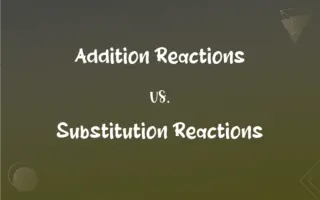Locust vs. Grasshopper: What's the Difference?
Edited by Aimie Carlson || By Harlon Moss || Updated on July 4, 2024
Locusts are grasshoppers that change behavior and form swarms under certain conditions. Grasshoppers are insects that typically remain solitary.

Key Differences
Locusts and grasshoppers are both members of the Acrididae family. While they share many similarities, their behavior and impact on the environment are what set them apart. Locusts, under specific conditions, can change their behavior and physiology, transitioning from a solitary phase to a gregarious, swarming phase. Grasshoppers, on the other hand, typically lead solitary lives and do not form large swarms. They are characterized by their long hind legs, which they use for jumping, and are commonly found in grassy fields or meadows.
Locusts, especially during their swarming phase, can pose significant threats to agriculture. These swarms can cover vast areas and consume vast amounts of crops, leading to food shortages and economic devastation. The swarming behavior of locusts is a survival mechanism, allowing them to exploit resources rapidly.
Grasshoppers, while they can sometimes be pests in gardens or on farms, do not usually cause the widespread damage associated with locust swarms. It's crucial to understand the distinction between the two, as the term "locust" can often be misused to describe any large group of grasshoppers.
Both locusts and grasshoppers play roles in their ecosystems. While they can be pests to humans, they serve as food for many animals and help control vegetation. Distinguishing between the behavior of locusts and grasshoppers helps in managing and understanding their impact.
Comparison Chart
Behavior
Can switch between solitary and swarming
Typically solitary
ADVERTISEMENT
Impact on Agriculture
Can cause significant damage in swarms
Occasionally pests, but less destructive
Physiological Changes
Undergo changes when switching behaviors
Do not exhibit drastic behavioral shifts
Role in Ecosystem
Both a pest and a food source for other animals
Food for many animals, helps control vegetation
Common Habitats
Found worldwide, especially in arid regions
Grassy fields, meadows, and various habitats
Locust and Grasshopper Definitions
Locust
Locusts can change their behavior and appearance under specific conditions.
After rain, a solitary locust can transform into its gregarious form.
ADVERTISEMENT
Grasshopper
Grasshoppers can be found in various habitats worldwide.
The meadow was filled with the sound of chirping grasshoppers.
Locust
Locusts are certain species of short-horned grasshoppers.
The desert locust is a well-known species that can form massive swarms.
Grasshopper
Grasshoppers are herbivores, primarily feeding on plants.
The grasshopper was munching on a green leaf.
Locust
Locusts are known for their swarming behavior.
A locust swarm can cover several square miles.
Grasshopper
Grasshoppers are insects with powerful hind legs for jumping.
The grasshopper leaped away when I approached.
Locust
Locust swarms are a survival mechanism for exploiting resources.
A locust swarm moves to areas with abundant food.
Grasshopper
Grasshoppers are typically solitary insects.
I spotted a lone grasshopper on the leaf.
Locust
Locusts can pose significant threats to agriculture.
Farmers dread locust invasions due to the potential for crop loss.
Grasshopper
Grasshoppers have antennae that are shorter than their body.
The grasshopper's antennae twitched as it sensed movement.
Locust
Any of various short-horned grasshoppers that sometimes migrate in immense swarms, devouring vegetation and crops.
Grasshopper
Any of numerous orthopteran insects, chiefly of the suborder Caelifera, characteristically having long, powerful hind legs adapted for jumping.
Locust
A cicada, especially a periodical cicada.
Grasshopper
A light, usually unarmed airplane used for liaison and scouting.
FAQs
Why do locusts swarm?
Swarming is a survival mechanism allowing locusts to rapidly exploit resources.
Are grasshoppers and locusts the same?
No, while locusts are a type of grasshopper, they have distinct behaviors, especially swarming.
What triggers the change in locust behavior?
Factors like increased population density and environmental conditions can trigger the change.
Are grasshoppers harmful to crops?
Occasionally, but they're less destructive compared to locust swarms.
Do grasshoppers have wings?
Yes, most adult grasshoppers have wings and can fly.
What are locusts?
Locusts are certain species of short-horned grasshoppers known for swarming behavior.
How do locust swarms affect the economy?
Locust swarms can devastate agriculture, leading to food shortages and economic loss.
How long do grasshoppers live?
Typically, a few months, depending on the species and environment.
Are locust swarms predictable?
While difficult, experts use various methods to predict and track locust swarms.
What's the largest grasshopper species?
The Giant grasshopper from Australia is one of the largest species.
Do grasshoppers make sounds?
Yes, they produce sounds by rubbing their legs against their wings or abdomen.
Where are locusts commonly found?
They are found worldwide, especially in arid regions prone to swarming.
What's the difference between locusts and crickets?
Crickets are from a different family and are known for their chirping, while locusts are known for swarming.
Can grasshoppers be beneficial?
Yes, they serve as food for many animals and help control vegetation.
How do countries manage locust invasions?
They use monitoring systems, pesticides, and other control measures.
Are there different types of grasshoppers?
Yes, there are over 11,000 species of grasshoppers.
Why are locusts mentioned in biblical plagues?
Locust swarms were devastating events, making them notable for historical records.
Are locusts edible?
Yes, in many cultures, locusts are consumed as a source of protein.
What do locusts eat?
Locusts eat plants and can consume their body weight in food daily.
How far can a grasshopper jump?
Many grasshoppers can jump 20 times the length of their body.
About Author
Written by
Harlon MossHarlon is a seasoned quality moderator and accomplished content writer for Difference Wiki. An alumnus of the prestigious University of California, he earned his degree in Computer Science. Leveraging his academic background, Harlon brings a meticulous and informed perspective to his work, ensuring content accuracy and excellence.
Edited by
Aimie CarlsonAimie Carlson, holding a master's degree in English literature, is a fervent English language enthusiast. She lends her writing talents to Difference Wiki, a prominent website that specializes in comparisons, offering readers insightful analyses that both captivate and inform.
































































